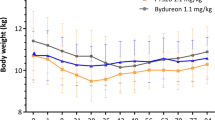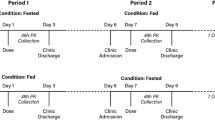Summary
Etodolac exhibits linear pharmacokinetics, good oral bioavailability, greater than 99% protein binding, a low oral clearance (almost exclusively non-renal), a relatively small volume of distribution and a half-life that averages 7.3±4.0 h. No significant pharmacokinetic differences have been noted in patients with mild to moderate renal impairment, in patients with cirrhosis, in the elderly or in patients with arthritis. The pharmacodynamics of the drug are well characterized in terms of pain intensity differences (PID) yielding an EC50 of 13 μg/ml. The extensive kinetic/dynamica characterization of etodolac, together with its short half-life, makes the drug an ideal candidate for a sustained-release (SR), once-a-day formulation. Etodolac SR formulations exhibit the same pharmacokinetic characteristics as the conventional-release (CR) formulation, except for a longer time to peak concentration and a lower peak concentration. Fluctuation ratios upon multiple dosing are comparable for equal total daily doses of etodolac SR and twice-daily doses of the CR formulation. Administration with food (high-fat meal) did not affect areas under the curve for either the CR or the SR product. Simulation analyses for etodolac SR suggest that PID responses are maintained over 24 h.
Similar content being viewed by others
References
Anonymous (1993) Lodine®. In: Physicians' desk reference, 47th edn. Medical Economics Data, Montvale, NJ, pp 2581–2584
Balfour JA, Buckley MM-T (1991) Etodolac: a reappraisal of its pharmacology and therapeutic use in rheumatic diseases and pain states. Drugs 42:274–299
Benet LZ, Williams RL (1990) Design and optimization of dosage regimens; Pharmacokinetic data. In: Gilman AG, Rall TW, Nies AS, Taylor P (eds) The pharmacological basis of therapeutics, 8th edn, Appendix II. Pergamon, New York, pp 1650–1735
Brater DC, Lasseter KC (1989) Profile of etodolac: pharmacokinetic evaluation in special populations. Clin Rheumatol 8:25–35
Chiang S, Ermer JC, Kraml M, Sanda M, Conrad K (1990) Steady-state dose-proportionality of etodolac SR. Clin Pharmacol Ther 47:192
Author information
Authors and Affiliations
Rights and permissions
About this article
Cite this article
Benet, L.Z. Pharmacokinetics of sustained-release etodolac. Rheumatol Int 13 (Suppl 2), S3–S5 (1993). https://doi.org/10.1007/BF00290277
Issue Date:
DOI: https://doi.org/10.1007/BF00290277




